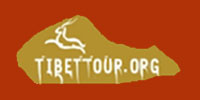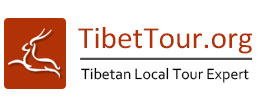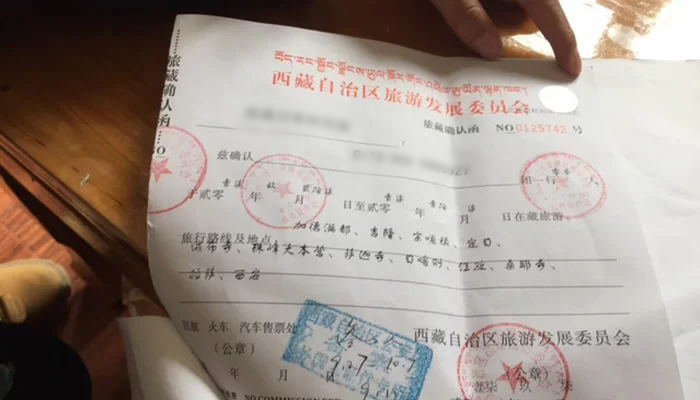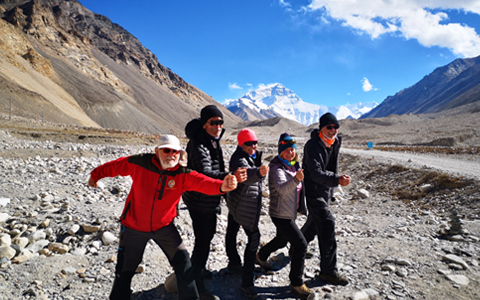Tibet attracts visitors from all over the world to witness its natural wonders and be immersed in the ancient spiritual culture. From the iconic Potala Palace to the serene shores of Yamdrok Lake, it is a realm with a lifetime’s worth of natural and cultural attractions to explore. Among the many great places to visit, here are the top 20 attractions in Tibet.
1. (Must-See) Potala Palace: A UNESCO Heritage and Tibetan Cultural Icon
Potala Palace is an architectural marvel that has stood as a symbol of Tibetan culture and history for centuries. Set atop Marpo Ri, known as “Red Hill”, the palace overlooks the city of Lhasa.
 As a symbol of Tibet, Potala Palace is a must-see for tourists.
As a symbol of Tibet, Potala Palace is a must-see for tourists.It was initially built in the 7th century, but the present structure with the two main sections, the Red Palace and the White Palace, was reconstructed by the 5th Dalai Lama in 1645. Designated as a UNESCO World Heritage Site in 1994, the palace wows thousands of visitors every year with its preservation of the rich cultural heritage of Tibet.
To visit the Potala Palace, be sure to purchase your tickets in advance, especially during the peak tourist season. Only 2,300 tickets for the Potala Palace are issued each day, with 1,600 allocated to travel agents and 700 for individual visitors. Additionally, remember to wear comfortable walking shoes for climbing the stairs and to respect local customs while visiting.
2. (Must-See) Mount Everest: Conquering the Roof of the World
Mount Everest is famous worldwide as the highest point on earth. At an elevation of 8,848.86 meters, this iconic peak is situated in the Himalayas on the border between Nepal and Tibet. Climbing Mt Everest is only for a very few, but it’s still possible to get a great experience of the mountain from Everest Base Camp (EBC).
 Tourists visit the Tibet Everest Base Camp.
Tourists visit the Tibet Everest Base Camp. The best way to see Mt Everest is to travel to EBC from Lhasa. Along the way, there are many opportunities to visit historic Tibetan cities like Gyantse and Shigatse, home to ancient monasteries such as Tashilhunpo Monastery. The journey from Lhasa to EBC also allows for gradual acclimatization to the high altitude. Altitude sickness is a major concern for visitors to the Tibetan Plateau, and the slowly rising approach is an effective way to help avoid it.
The majestic sight of Mt. Everest from EBC can only be described as awe-inspiring. The best times to enjoy a clear view of the peak are before and after the monsoon seasons in April-May and September-November. With more stable weather conditions during these periods, reaching there and witnessing the mountain in all its splendor will undoubtedly be an unforgettable experience.
3. (Must-See) Mount Kailash: The Center of the Universe by Four Religions
At an altitude of 6,656 meters, Mt. Kailash means Mountain of God in Tibetan, which is worshiped as the holy mountain by four major religions, including Bön, Buddhism, Hinduism, and Jainism.
 Tibetan antelope seen around the grassland near Mt.Kailash.
Tibetan antelope seen around the grassland near Mt.Kailash.Countless pilgrims from all over the world do the Kailash Kora trek every year. Apart from the religious influence, the majestic Mt. Kailash with its snow-covered peak all year along is worth your coming.
Visiting Mount Kailash can be a physically demanding journey, so it’s important to pay special attention to health and safety. Consult a doctor before you go, and discuss altitude sickness medication. Carry a basic first aid kit and any necessary medications with you on your trek.
4. (Must-See) Jokhang Temple: The Holiest Temple Revered by Tibetans
Built in the 7th century, and expanded and renovated over the centuries, Jokhang Temple stands today as the holiest temple in Tibet. Located in Lhasa, it is considered a symbol of Tibetan Buddhism and the spiritual center of the city.
 Jokhang Temple is the holiest Temple revered by Tibetans.
Jokhang Temple is the holiest Temple revered by Tibetans.The design showcases a unique blend of architectural styles, blending Tibetan, Nepalese, and Indian influences. Its distinctive appearance comes from a combination of wood, stone and murals, with a central golden-roofed shrine adorned with prayer flags.
Visitors to Jokhang Temple should dress modestly with shoulders and knees covered in respect for the sacredness of the site. Some areas of the temple might not allow photography, and others may have specific guidelines. When in doubt of local customs, always ask.
5. (Must-See) Barkhor Street: Immersing in Traditional Tibetan Life
In the heart of Lhasa, Barkhor Street is a historic market that encircles Jokhang Temple. It is a unique window into traditional Tibetan life and a place where spiritual devotion, commerce, and cultural exchange intersect. Besides a place to buy local goods and beautiful traditional crafts such as prayer flags, thangka paintings, and jewelry, it is also an important pilgrimage site.
 Tourists tend to buy Tibetan souvenirs on Barkhor Street.
Tourists tend to buy Tibetan souvenirs on Barkhor Street.Be respectful of the pilgrims when visiting the market. It’s best to give them space and try to stay out of their way. When shopping, bargaining is not disrespectful, but don’t take it too far, and keep it friendly.
6. (Must-See) Lake Yamdrok: A Turquoise Gem Nestled in the Himalayas
Lake Yamdrok is renowned for its stunning color, the vibrant turquoise hues a perfect accent to the picturesque landscape of snow-capped mountains, and lush green valleys that surround it.
 Lake Yamdrok is like a turquoise gem on the plateau.
Lake Yamdrok is like a turquoise gem on the plateau.Located around 100 km southwest of Lhasa, and at an altitude of around 4,441 meters, where the crisp, clean air adds to the natural beauty. It is also a sacred site to Tibetans, with the surrounding region home to numerous monasteries. Pilgrims travel to Lake Yamdrok to walk the kora route around the lake, the full route taking several days to complete.
The high altitude of Lake Yamdrok means altitude sickness is an important concern. Visitors are advised to acclimatize properly, spending a few days in Lhasa or a similar location before going. While there you need to be prepared for rapid weather changes. Dress in layers and be ready for strong sun, wind, and potential rain or snowfall.
7. (Must-See) Sera Monastery: Witnessing Interesting Monk Debates
At Sera Monastery, on the outskirts of Lhasa, the centuries-old tradition of monk debates continues into the modern day. Two monks face off in the monastery’s courtyard, taking different sides of a particular viewpoint. This traditional practice is an important part of Tibetan Buddhist education, and a way for monks to deepen their understanding of Buddhist teachings.
 Monks are debating at the courtyard of Sera Monastery.
Monks are debating at the courtyard of Sera Monastery.While the debates are conducted in the Tibetan language, the gestures and interactions that are part of the tradition make it a captivating experience for non-Tibetan speakers. The debates are open to the public and normally held from 3-5 p.m. You can check the schedule before going. Spectators are expected to be respectful of the practice and not interrupt the proceedings.
8. (Must-See) Tashilhunpo Monastery: The Seat of the Panchen Lama
Tashilhunpo Monastery holds a special place in Tibetan Buddhism as the traditional seat of the Panchen Lama, one of the highest-ranking lamas in Tibetan Buddhism. Located in Shigatse in the southwestern part of Tibet, the monastery was first established in 1447 by the first Dalai Lama. It is renowned not only for its spiritual importance, but also for its impressive architecture that blends Tibetan and Han Chinese styles.
 Tashilhunpo Monastery sits in the west of Shigatse.
Tashilhunpo Monastery sits in the west of Shigatse.Tashilunpo Monastery houses many Buddhism manuscripts, Buddha Statues and Stupas. Besides that, a grand three-day festival would be held in Tashilunpo Monastery every year. During the Tashilunpo Festival, three different thangkas would be unveiled respectively to remind people to cherish the past, enjoy happy lives, and hold hope for the future three days. And cham dances are performed. If time allows, you can time your trip with Tibetan festivals.
9. (Must-See) Ganden Monastery: A Tranquil Haven with Scenic Trekking Routes
Ganden Monastery is a serene haven for spiritual seekers and outdoor enthusiasts. Located on Wangbur Mountain, around 45 km northeast of Lhasa, it is known for its historical significance and surrounding natural beauty.
 Ganden Monastery lies in a hilly natural amphitheater.
Ganden Monastery lies in a hilly natural amphitheater.It is also home to one of the most popular trekking routes in Tibet. The Ganden to Samye trek is a multi-day trek that passes through a diverse landscape of alpine meadows, mountain passes, and river valleys.
The trekking routes around Ganden Monastery involve challenging terrain and high altitudes. It’s best to spend a few days in Lhasa or a nearby area to acclimatize before starting the trek. April to October is the best time to visit the area with more trails accessible, and more stable weather.
10. (Must-See) Lake Namtso: Gaining Spiritual Renewal Amidst Stunning Views
Lake Namtso is one of the highest lakes in the world, and a place of stunning beauty. Often referred to as “Heavenly Lake”, it is one of the three sacred lakes of Tibet. Pilgrims travel there for Lake Namtso Kora, the circumambulation of the lake seeking blessings and purification. Due to its high elevation and remote location, the clear, unpolluted skies make it an amazing place for stargazing with stunning views of celestial bodies.
 Crystal-blue Namtso Lake with snow-capped mountains as the background
Crystal-blue Namtso Lake with snow-capped mountains as the backgroundConsider joining our Lhasa to Namtso Lake tour. A one-day tour starting from Lhasa is a great way to experience the stunning landscape of the region. In the warmer weather between June and September, you can see the lake area at its peak lushness, with the surrounding grasslands blooming with valuable medicinal plants such as the Chinese caterpillar fungus, fritillaria, and the snow lotus flower.
11. (Must-See) Palcho Monastery: Exploring the Famous Kumbum Stupa
Palcho Monastery, located in the historic town of Gyanstse, is home to one of the most famous structures in Tibet. The Kumbum Stupa, also known as the "100,000 Buddha Pagoda," is the centerpiece of Palcho Monastery.
 Visiting the Palcho Monastery and Kumbum Stupa.
Visiting the Palcho Monastery and Kumbum Stupa.It is a multi-story building packed with chapels and galleries that are filled with beautiful murals, sculptures, and religious artifacts. Each floor of the stupa represents a different religious tradition, and the building stands as an example of the harmonious blending of different branches of Buddhism that has given rise to the unique culture of Tibet.
July and August is the peak season for Palcho Monastery. Crowds can get large during this time so it is a good idea to arrive early, if possible. Spring and fall can be a better time to visit. The weather remains milder than the harsh winter, and fewer tourists mean you can have a more contemplative experience.
12. (Must-See) Samye Monastery: The First Buddhist Monastery in Tibet
Samye Monastery was founded in the 8th century and holds the singular position of being the first Buddhist Monastery in Tibet. Its construction marked the integration of Indian and Tibetan Buddhist traditions, and the beginning of strong Buddhist influence in the region.
Of the monastery’s many remarkable features, one standout is an architectural layout that represents the Buddhist universe with a central temple symbolizing Mount Meru, and surrounding buildings representing continents and subcontinents.
 Visiting Samye Monastery, the first Buddhist monastery in Tibet
Visiting Samye Monastery, the first Buddhist monastery in TibetA guided tour is a great way to experience Samye Monastery. The rich history behind the site and deeply symbolic design and construction make it a place where the insights and context of an experienced guide can be particularly meaningful. The right guide will help you come away with a better understanding of local history and culture.
13. (Optional) Norbulingka Palace: The Summer Retreat of the Dalai Lama
Norbulingka Palace, known as “Jewel Park”, served as the traditional summer residence of the Dalai Lama. It is a historic palace and garden complex located in Lhasa built during the 18th century, and expanded over the years.
 Norbulingka Palace is also a good place to explore in Lhasa.
Norbulingka Palace is also a good place to explore in Lhasa.The palace is surrounded by delicately manicured lawns and expansive gardens designed to be both beautiful and a place for relaxation. The palace itself is bland of Tibetan, Chinese, and Indian architecture, adorned with intricate designs and vibrant colors.
Try to time your visit for the summer months when the gardens are in full bloom. Mornings offer a calmer experience with smaller crowds and the sights of the palace and gardens coming to life for the day.
14. (Optional) Gama Valley: The Most Enchanting Valley in Everest Region
Gama Valley has been praised as one of the most beautiful valleys in the world and is a top trekking route worldwide with its unique and awe-inspiring landscape.
 Gama Valley offers beautiful landscape.
Gama Valley offers beautiful landscape.The valley is 8 km wide and 55 km long, passing through a range of ecological zones that include woodlands, alpine meadows, and deserts. It’s not easy to get to, horse or yak is the only transportation available, but the amazing views of the mountains, and ecological diversity make it well worth it for avid trekkers.
Our Gama Valley Trek is a 15-day epic adventure through the beautiful landscape on Mt. Everest’s eastern side. The journey starts in Lhasa and travels through Yamdrok Lake and Shigatse. Along the way, you’ll be awestruck by views of Mt. Everest, Mt. Lhotse, and Mt. Makalu, and get to experience local Tibetan culture with visits to picturesque villages like Lhundupling. It is a challenging, but unforgettable experience, perfect for those wanting a deep look at the Himalayan region.
15. (Optional) Guge Kingdom: Unveiling Ancient Civilization's Ruins
The Guge Kingdom was a historic civilization that flourished in the region of western Tibet from the 9th to the 17th century. Known for its cultural, artistic, and religious achievements, the ruins of the Guge Kingdom continue to reveal many insights into its ancient culture.
 Exploring Guge Kingdom when traveling to Ngari.
Exploring Guge Kingdom when traveling to Ngari.The ruins of palace complexes and monasteries with their sculptures and murals are a window into a people and way of life that thrived in the harsh landscape.
Ngari Prefecture, where the ruins of the Guge Kingdom are located is very remote. Long travel times and limited amenities should be expected. You’ll need to bring everything you need with you, from clothing suited to changing weather conditions, medicine and anything else you can’t do without. Items you forgot to pack may not be available to purchase there.
16. (Optional) Zanda Earth Forest: Exploring Unique Geological Formations
Also in Ngari prefecture, the Zanda Earth Forest is a unique geological formation of eroded rock that resemble intricate sculptures and pillars. Over the centuries, wind and rain have stripped away layers of the sedimentary rock leaving behind an almost alien landscape of vibrant colors in the rock from the different mineral layers that have been revealed.
 Exploring Zanda Earth Forest unique geological formations.
Exploring Zanda Earth Forest unique geological formations.Zanda Earth Forest is an incredible opportunity for photographers to capture unique shots of the towering pillars. The best light falls during the golden hours of sunrise and sunset, when the warm light accentuates the colors and textures of the formations.
17. (Optional) Mount Namjagbarwa: The Most Beautiful Mountain in China
Mount Namjagbarwa is a geological marvel that stands out in a land of geological marvels. Considered by some as the most beautiful mountain in China, it is known for towering cliffs that rise dramatically from the valleys below. The Yarlung Tsanpo River flows through a deep gorge formed by the mountain, one of the deepest and most inaccessible canyons in the world that lies in stark contrast to the rugged peak above.
 Mount Namjagbarwa can be seen from the Yarlung Tsanpo River valley.
Mount Namjagbarwa can be seen from the Yarlung Tsanpo River valley.Located in the southeastern part of Tibet, travel to Mount Namjagbarwa takes careful planning due to its remote location and challenging terrain. Visitors planning to go to the mountain need to be prepared for unpredictable weather and have spent time properly acclimatizing beforehand as medical facilities and communication service can be limited in the area.
18. (Optional) Lulang Forest: A Picturesque Alpine Valley in Nyingchi
The tranquil ambiance of Luland Forest makes it a perfect destination for nature lovers. Located in Nyingchi Prefecture, it is famous for its lush green meadows, pristine forests, and stunning views of the Himalayas. The sharp contrast of the mix of landscapes creates a unique visual appeal to the area whether for photography or just spending time enjoying the scenery.
 Exploring Lulang Forest in pcturesque alpine valley in Nyingchi.
Exploring Lulang Forest in pcturesque alpine valley in Nyingchi.Weather can change quickly in alpine regions such as Lulang Forest. Visitors should dress in layers and be prepared for colder weather, particularly when taking part in the many outdoor activities it has to offer such as hiking or horseback riding.
19. (Optional) Yungbulakang: Tibet's Oldest Palace and Legendary Origin
Yungbulakang is a place at the intersection of history and legend. Believed to have been built in the 2nd century BCE, it is one of the most ancient structures in Tibet and the oldest palace. According to legend, Yungbulakang is associated with the origin of the Tibetan people as the place where the divine monkey and his consort descended from the sky and gave birth to the Tibetan race.
 Yungbulakang is Tibet's oldest palace and legendary origin.
Yungbulakang is Tibet's oldest palace and legendary origin.Late spring, May to June, through early autumn, September to October, is an excellent time to visit Yungbulakang. The flowers in the surrounding landscape are in bloom, and the weather is warm and pleasant.
20. (Optional) Sakya Monastery: A Treasury of Buddhist Knowledge and Art
Sakya Monastery is the center of the Sakya school of Tibetan Buddhism which emphasizes a balanced approach to study, meditation and practice. As part of its long scholarly tradition, the monastery is home to an extensive collection of religious artifacts, manuscripts, and murals that offer insights into Tibetan culture and history.
Also notable is the architecture. With gray walls and a fortress-like appearance, Sakya Monastery reflects the blending of Tibetan and Mongolian styles.
 Sakya Monastery - A treasury of buddhist knowledge and art.
Sakya Monastery - A treasury of buddhist knowledge and art.A guided tour is recommended in order to learn more about the historical collection housed in Sakya Monastery. Viewing alone is still a rewarding experience, but the scholarly and esoteric traditions behind the art and artifacts of the monastery come alive with a knowledgeable guide providing context.
Conclusion
With so many attractions to see in Tibet, there is something for everyone. From unique natural landscapes, to ancient history and culture, this list is an introduction to some of the must-see places to go in Tibet. Our tour packages are designed with both specific interests in mind, and for those who want a broader experience of a little bit of everything. Contact us for more information to start planning the experience of a lifetime.

























 As a symbol of Tibet, Potala Palace is a must-see for tourists.
As a symbol of Tibet, Potala Palace is a must-see for tourists.
 Tourists visit the Tibet Everest Base Camp.
Tourists visit the Tibet Everest Base Camp.  Tibetan antelope seen around the grassland near Mt.Kailash.
Tibetan antelope seen around the grassland near Mt.Kailash. Jokhang Temple is the holiest Temple revered by Tibetans.
Jokhang Temple is the holiest Temple revered by Tibetans. Tourists tend to buy Tibetan souvenirs on Barkhor Street.
Tourists tend to buy Tibetan souvenirs on Barkhor Street. Lake Yamdrok is like a turquoise gem on the plateau.
Lake Yamdrok is like a turquoise gem on the plateau.
 Monks are debating at the courtyard of Sera Monastery.
Monks are debating at the courtyard of Sera Monastery. Tashilhunpo Monastery sits in the west of Shigatse.
Tashilhunpo Monastery sits in the west of Shigatse. Ganden Monastery lies in a hilly natural amphitheater.
Ganden Monastery lies in a hilly natural amphitheater. Crystal-blue Namtso Lake with snow-capped mountains as the background
Crystal-blue Namtso Lake with snow-capped mountains as the background Visiting the Palcho Monastery and Kumbum Stupa.
Visiting the Palcho Monastery and Kumbum Stupa. Visiting Samye Monastery, the first Buddhist monastery in Tibet
Visiting Samye Monastery, the first Buddhist monastery in Tibet Norbulingka Palace is also a good place to explore in Lhasa.
Norbulingka Palace is also a good place to explore in Lhasa. Gama Valley offers beautiful landscape.
Gama Valley offers beautiful landscape. Exploring Guge Kingdom when traveling to Ngari.
Exploring Guge Kingdom when traveling to Ngari.
 Exploring Zanda Earth Forest unique geological formations.
Exploring Zanda Earth Forest unique geological formations. Mount Namjagbarwa can be seen from the Yarlung Tsanpo River valley.
Mount Namjagbarwa can be seen from the Yarlung Tsanpo River valley. Exploring Lulang Forest in pcturesque alpine valley in Nyingchi.
Exploring Lulang Forest in pcturesque alpine valley in Nyingchi. Yungbulakang is Tibet's oldest palace and legendary origin.
Yungbulakang is Tibet's oldest palace and legendary origin. Sakya Monastery - A treasury of buddhist knowledge and art.
Sakya Monastery - A treasury of buddhist knowledge and art.








Ask a Quick Question